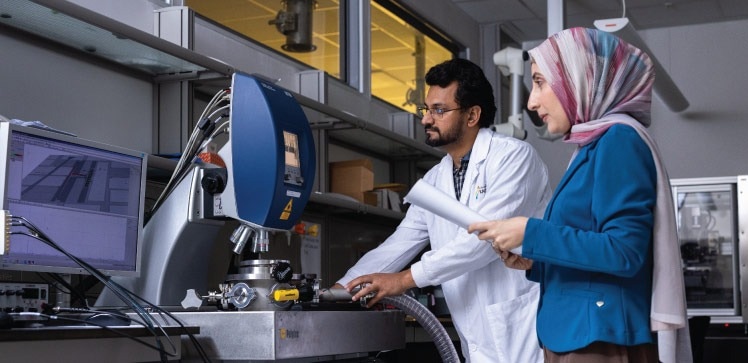Reviewed by Emily Henderson, B.Sc.Nov 11 2022
A chemical sensor installed with artificial intelligence (AI) can be taught to identify specific gases in the air with high selectivity and sensitivity.
 Usman Yaqoob and Nouha Alcheikh developed a chemical sensor that can detect specific molecules in the air. Image Credit: © 2022 King Abdullah University of Science and Technology.
Usman Yaqoob and Nouha Alcheikh developed a chemical sensor that can detect specific molecules in the air. Image Credit: © 2022 King Abdullah University of Science and Technology.
Engineered by researchers at King Abdullah University of Science and Technology (KAUST), the device employs machine learning to distinguish between the gases according to the way they trigger slight temperature variations in the sensor as they interact with it.
Smart electronic sensors that can sense particular airborne molecules are progressively in demand for applications ranging from medical diagnostics to the detection of hazardous industrial gas leakages.
The challenge is to precisely identify the target gas among the compound mixture of chemicals usually found in the air, says Usman Yaqoob, a postdoctoral researcher in the lab of Mohammad Younis, who directed the study.
“Existing sensing technologies still suffer from cross-sensitivity,” Yaqoob says.
Instead of seeking unusual materials or dedicated coatings to enhance sensor selectivity, the researchers are applying machine learning. On the hardware side, a heated strip of silicon, known as a microbeam resonator, forms the device's core.
When the microbeam is fastened at both ends so that it is bent nearly to the buckling point, the frequency at which the microbeam resonates is highly responsive to variations in temperature.
When operated near buckling point, the heated microbeam shows significant sensitivity to different gases when they have a heat conductivity lower or higher than air.
Usman Yaqoob, Postdoctoral Researcher, Lab of Mohammad Younis, King Abdullah University of Science and Technology
Gases with a higher thermal conductivity than air, such as hydrogen and helium, cool the microbeam, raising its stiffness and resonance frequency. Gases like argon, with a lower thermal conductivity, exhibit the opposite effect.
“The shift in resonance frequency is detected using a microsystem analyzer vibrometer,” Yaqoob says.
The researchers then used AI to examine the data and find characteristic variations in resonance frequency correlating to the various gases.
“Data processing and machine learning algorithms are used to generate unique signature markers for each tested gas to develop an accurate and selective gas classification model,” Yaqoob says.
Once programmed on data from the sensor’s response to argon, helium, and carbon dioxide, the algorithm could detect these gases with 100% accuracy in an unidentified dataset.
Unlike traditional gas sensors, our sensor does not require any special coating, which enhances the chemical stability of the device and also makes it scalable. You can scale the device down to the nano-regime without affecting its performance since it does need a big surface for the coating.
Mohammad Younis, Study Lead Author, King Abdullah University of Science and Technology
Journal Reference:
Yaqoob, U., et al. (2022) Highly selective multiple gases detection using a thermal-conductivity-based MEMS resonator and machine learning. IEEE Sensors. doi.org/10.1109/JSEN.2022.3203816.